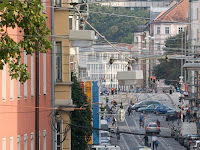You will understand if you look at this picture (it's not the 24-70 but the similarly-sized 16-35):
On top of it, the Tamron is almost half the weight. I can insure you that you will notice when carrying the A900 with one lens or the other.
Maybe the Tamron is not the best example. After all, even if it can give very good pictures, I have had AF problems with it regularly.
I also commented about the 24-105 being an "ideal travel lens". Let us look at the difference:
Of course, you can even go smaller and lighter if you use a prime, here the 50mm:
Or look at the difference between the old 135mm f/2.8 prime and the huge 70-200 f/2.8 G zoom:
(and the prime has even a built-in hood... why don't they do that any more?)
Bottom line: there is more to a lens than test pictures. The lens with the worst picture quality is the one you left at home...
And it seem that every manufacturer is building their 35mm lenses bigger and heavier nowadays.

































































